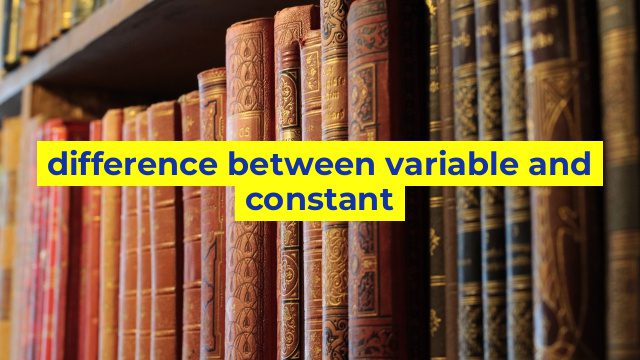Variable vs Constant: What’s the Difference?
When you start learning to code, one of the first things you’ll likely learn about is variables and constants. Both are essential building blocks of programming languages and are used to store values. However, there are some differences between them that you should be aware of. In this article, we’ll explore what those differences are and why they matter.
What are Variables?
A variable is a container that holds a value, which can change. It’s essentially a named memory location that can store different values throughout the program’s execution. When a value is assigned to a variable, that value is stored in the memory location associated with the variable name. Then, the program can access and modify that value as needed.
For example, let’s say you want to store the user’s age in your program. You would create a variable called “age” and assign the user’s age to it.
age = 27;
Now you can use the variable “age” throughout the program to refer to the user’s age.
What are Constants?
A constant, on the other hand, is a value that cannot be modified. It’s like a variable, but the value is fixed when it is declared, and it cannot be changed throughout the program’s execution. Constants are typically used for values that do not change, such as mathematical constants or program settings that should not be modified.
To declare a constant in most programming languages, you use the “const” keyword.
const pi = 3.14;
In this example, “pi” is a constant with a value of 3.14. This value cannot be changed throughout the program.
What’s the Difference?
The primary difference between variables and constants is that variables can hold different values throughout the program, while constants hold a fixed value that cannot be changed.
Variables are typically used for values that can change, such as user input, calculations, or program state. Constants, on the other hand, are used for values that do not change, such as mathematical constants or program settings.
Another difference between variables and constants is their naming convention. Variables are typically named using camelCase, with the first letter lowercase and subsequent words capitalized. In contrast, constants are typically named using all uppercase letters, with underscores between words.
Why Does it Matter?
Understanding the difference between variables and constants is essential for writing effective, bug-free code. If you try to modify the value of a constant, your code will break, and it can be challenging to debug. Similarly, if you try to use a variable that hasn’t been initialized, your program may crash or produce unexpected results.
By using variables and constants correctly and understanding their differences, you can write more efficient, maintainable code and avoid common programming errors.
Conclusion
Variables and constants are fundamental concepts in programming, and understanding the difference between them is crucial. Variables can hold different values throughout the program, while constants are fixed values that cannot be changed. By using variables and constants appropriately, you can write better code and avoid common errors.
Table difference between variable and constant
| Variable | Constant |
| A variable is a value that can change. | A constant is a value that cannot change. |
| The value of a variable can be assigned, modified, and used multiple times throughout the program. | The value of a constant is assigned only once and remains the same throughout the program. |
| Variables are declared using the var keyword. | Constants are declared using the const keyword. |
| Variables are often used to store data that will be modified or manipulated in some way. | Constants are often used to store values that are known and defined at the start of the program and will not change. |


